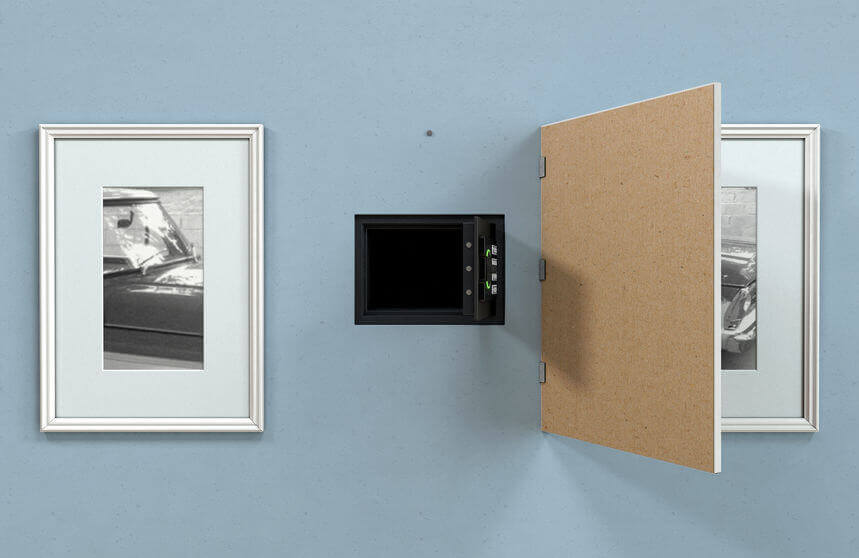
Fireproof. Lock box. Floor. Wall.
These are all words to describe different types of safes. Putting your valuables inside a secure box is a great idea. But most commercial safes don’t take much to open. That’s why a hidden safe is perhaps the best way to preserve things from thieves.
Essentially, you’re taking a normal safe or lock box and putting it somewhere only you know about.
One of the first questions is usually, “where do I hide my safe?” It’s probably better to first cover some common mistakes.
- Don’t hide valuables in common hiding spots. Books, the freezer and under the bed are some of the first places checked during a home invasion.
- Make sure it’s big enough. As time passes, you’ll get more important items and documents. Some of these will be bigger than others.
- Do quality work with quality materials. If you put a safe in your closet and it looks totally different — the safe isn’t really hidden to intruders.
Next, before hiding a safe, you should choose the type of safe. Some examples include:
- Wall Safe: These can be put directly in the wall, but may be more difficult to conceal, since paintings are a commonly searched spot during burglaries.
- Fireproof/Waterproof: Having added layers of protection is always a good thing and a safe which can resist fire and water is a great option.
- Large Safes: The bigger the safe, the harder it is to hide. In this case, you could create or convert a small space into a hidden room.
Now, onto the main subject — 5 different places to put a hidden safe.
5 Places to Hide Your Hidden Safe
1. Put a Hidden Safe in a Vent
Vents are a part of nearly every home and apartment. Given their abundance in culture, these fixtures go unnoticed by almost everyone — including home intruders.
Typically, this involves cutting a hole in either the floor or the wall (depending on the location of the rest of your vents). Many of these vent safes are pre-made for purchase. Simply cut the hole the size of your vent safe and place it for quick access.
Tip: Using a vent safe is great, because even if a thief knows about this idea, it would take a lot of time to pull up all the vents in a home.
2. Put a Safe Beneath Floorboards
With basic woodworking skills, creating an integrated flooring compartment for your precious possessions is fairly simple.
- Choose an area of your floor (as long as it has a sub-floor and doesn’t have plumbing or wiring).
- Build a box to house your safe, securing the box to the floor joists with screws.
- Lastly, attach a slight hole for a handle to the lid and then put it back in the floor opening. Put your safe inside this fresh hiding spot and cover the lid with a carpeting or item of furniture.
Note: One of the main issues with any hidden door is finding a way to cover the reveal line that shows where the hidden door is at. SOSS has finally solved this problem for good. You can use the new SOSS 518 Wrap Around Hinge to conceal your floorboard safe even better!
3. Store Hidden Safes In the Walls
A safe mounted on the wall can be pried with a muscle and the right tools. To keep this from happening, there are two options:
- Hiding the Safe Well (either behind a painting or false wall)
- Mounted Securely in the Wall
4. Put a Safe in Your Stairs
This safe storage solution turns a step on your stairway into a compartment large enough to fit a strongbox or hidden safe. As would-be intruders search for your goods, they’ll never think to check underfoot!
For this, the stair with the safe must be no different from the rest. So, it’s usually best to remove the top part of the stair (or tread), put the safe inside and put the tread back on top.
5. Make a Room into a Hidden Safe
Using a small, or even tiny, room as a safe is a perfect way to hide larger goods — or even yourself.
Don’t have a good secret room to hide? Build one.
All you need is a few square feet, a hidden door and a few materials. A few places could include:
- A closet, especially where part of the closet sits behind a wall.
- Rooms in the middle of a house with a single entrance and no windows.
- Sections of the basement.
Ready to Hide Your Own Safe?
While there are a number of other tips to keep your valuables secure, having a place for certain items is a good plan. These ideas should help to create a great spot in your home or apartment for hidden safes.
Be sure to check out some of our other secret stash posts and let us know any place we may have missed with our list!